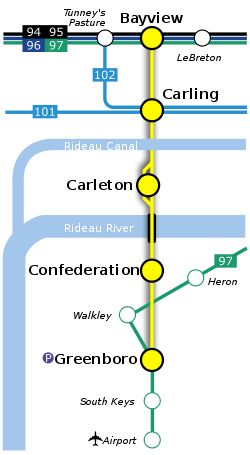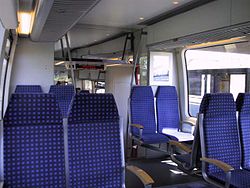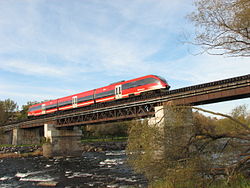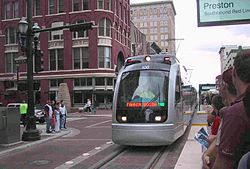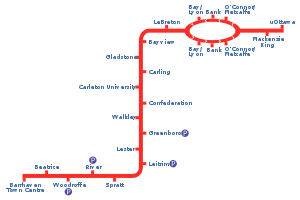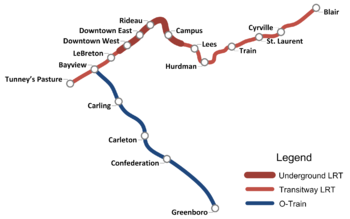- O-Train
-
For the basketball player nicknamed "O-Train", see Oscar Robertson.
O-Train 
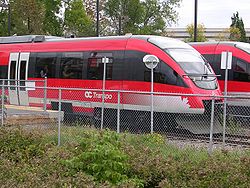
Info Locale Ottawa, Ontario Transit type Light Rail Number of lines 1 Number of stations 5 Daily ridership 14,200[1] Operation Began operation October 15, 2001 Operator(s) OC Transpo Technical Track gauge 1,435 mm (4 ft 8 1⁄2 in) (standard gauge) System map The O-Train is a light-rail transit (LRT) service in Ottawa, Ontario, Canada operated by OC Transpo. The present line runs north-south on a railway line, from Bayview to Greenboro, a distance of approximately 8 kilometres (5 mi). It is entirely isolated from road traffic, but shared with other trains; after operating hours the track has been infrequently used by Ottawa Central for freight service to the National Research Council.
Various explanations for the system’s name have been suggested; however, it was first put forth by copywriter Tom Gerylo at an Ottawa advertising agency working for OC Transpo. The name O-Train was based on the classic Duke Ellington signature tune "Take the 'A' Train", which refers to a New York City Subway service. In French, it is pronounced similarly to 'au train,' ('by train'). It survived an internal OC Transpo naming competition and was adopted soon after.
Since its opening on October 15, 2001, the O-Train hit the 1-millionth rider mark on May 29, 2002, the 5-millionth mark on January 21, 2005, and the 10-million in late 2010.[2]
Contents
Pilot project
The O-Train was introduced in 2001 as a pilot project to provide an alternative to the busways on which Ottawa had long depended exclusively for its high-grade transit service (see Ottawa Rapid Transit).
The present system uses three diesel-powered Bombardier Talent BR643 low-floor diesel multiple unit trains. It is legally considered a mainline railway despite being used for local public transport purposes, and the service it provides at present is, in terms of its route and service frequency, more like that of an urban railway than a metro or tramway. OC Transpo operates it under the official name of ‘Capital Railway’, which appears on the trains along with their regular logo. It was, however, described as ‘light rail’, partly because plans called for it to be extended into Ottawa’s downtown as a tramway-like service, and partly because the Talents, though designed for mainline railways in Europe, are much smaller and lighter than most mainline trains in North America, and do not meet the AAR's standards for crash strength. Ottawa is also authorized to run trains with only a single operator and no other crew, something quite rare on mainline railways in North America.
As a pilot project, the O-Train system was built at the cost of $21 million, relatively little compared with the hundreds of millions of dollars usually required to build a new transit line. It runs on a pre-existing Canadian Pacific Railway track (Ellwood and Prescott subdivisions,[3]) so the only construction work necessary was to build the stations themselves and the passing tracks necessary to allow trains to operate in both directions. The downside to this, however, is that much ground pollution remains from the track’s previous use. This will become a liability one day when the city has to pay to clean it up, which it has thus far avoided by not digging into the ground under the tracks.
The current service frequency of a train every fifteen minutes makes it possible to run the line with a fleet of only three trains (of which only two are in service at any given time) and a single track apart from passing sidings at Carleton station; if service is to be increased significantly in the future, double tracks and more trains will be needed.
Ottawa’s three Talent units were built by Bombardier Transportation as part of a larger order for Deutsche Bahn’s regional network, and the only significant difference between them and the German units is that their on-board toilets have been decommissioned. As well, the luggage racks have been blocked, although this seemed not to be a problem with the train's operation in Germany. Deutsche Bahn’s red-and-white colour scheme was deemed similar enough to OC Transpo’s livery that the trains did not need to be repainted. The trains were purchased under an agreement under which they could be sold back to Bombardier if they were replaced or retired, but the agreement has since expired.
As of mid 2011, the O-Train carried an average of approximately 12,000 riders each day.[4]
Route description
O-Train Legend





Former Ellwood Sub CPR 





Quebec 



Ottawa River border 





Prince of Wales Bridge 










(  Tunney's Pasture-Lebreton
Tunney's Pasture-Lebreton  )
)Transitway 



Bayview 










Gladstone (proposed) 





417 Queensway 




Carling 










Dow's Lake 





Rideau Canal tunnel 

















Carleton 











Rideau River 





Confederation 





Airport Parkway / Bronson Ave 





Ellwood Diamond (  Via Rail
Via Rail  )
)





Heron (  Billings Bridge )
Billings Bridge )Transitway 





Walkley (O-train proposed) 





Walkley Diamond / Walkley Yard (  OCR
OCR  )
)









Greenboro 





(  Airport )
Airport )Transitway 





(  Ottawa Central, Prescott Sub )
Ottawa Central, Prescott Sub )- Bayview provides an interchange with the Transitway and is the closest station to downtown Ottawa. It is located on a stub-end track branching off from the railway line, immediately under the Wellington Street and Transitway overpasses.
- Carling is located at Carling Avenue and Preston Street. South of Carling, the train enters a tunnel to pass under Dow's Lake.
- Carleton serves Carleton University, and is the location of the only passing loop on the route, with the consequence that Carleton is the only station with separate tracks and platforms for each direction. The schedule is timed such that the southbound train arrives first and moves onto the platform siding, and then proceeds once the northbound train has entered the station. South of Carleton, the train crosses over the Rideau River on a bridge.
- Confederation is located at Heron Road and Bronson Avenue, and primarily serves Government of Canada offices in the Confederation Heights area.
- Greenboro provides an interchange with a large Transitway station, which has a large park-and-ride lot and is located next to the South Keys Shopping Centre. The O-Train platform is level with the pedestrian overpass crossing the Transitway.
At the station
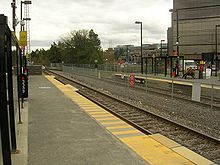 Carleton is the only station with two platforms.
Carleton is the only station with two platforms.
Carleton is the only O-Train station with separate platforms for both directions; at Carling and Confederation one can tell where a train is headed by the direction from which it enters the station and by its electronic destination sign.
Ticketing on the O-Train works entirely on a proof-of-payment basis; there are no ticket barriers or turnstiles, and the driver does not check fares. Occasionally, OC Transpo employees wait at stations and require proof of payment. Tickets can be purchased from a vending machine on the platform, and certain bus passes are also valid for the O-Train. O-Train tickets are exchanged for bus transfers upon boarding a bus. Although bus transfers can be used to board the O-Train, prepaid bus tickets cannot.
Paper schedules rather than electronic signs are posted at the stations to supply departure information. At the Carling and Confederation stations, signs are posted indicating the direction of travel for northbound and southbound trains; Carleton has separate platforms, and from Bayview and Greenboro trains travel in only one direction.
The O-Train stations have sheltered waiting areas for passengers, but at three stations these are only large bus-style shelters beside the tracks. The exceptions are Carling, where an elevator building is required since the tracks are below street level, and Greenboro, where a covered walkway extends towards the nearby South Keys Shopping Centre. All stations have level boarding platforms to allow for wheelchair access and easier boarding for all passengers.
The European train cars are narrower than the North American standard. In order to enable night-time use of the line by standard-width freight services, retractable platform extenders are mounted at each station (other than Bayview which is constructed on its own private rail spur). Passengers gain access to the O-Train on these extenders, three sets of which are visible in the above photo (at the location of the solid yellow platform markings). If the line is used for freight, the extenders are retracted allowing a wider train to pass through the station. The extender interface with the train has been refined over time, and cyclists and wheelchair users now have no trouble accessing the train.
On board the train
At present, the trains stop at every station and all trains run directly from one end of the line to the other (with only five stations, short-turns would be of questionable value). The Talent units can be coupled together to form longer trains, but current ridership levels do not require this extended service, which in any case would require more trains and longer platforms at the stations. Each of the three carriages has a plug-type doorway for each side of the train. Rather than all doors opening at each station, passengers must individually open the door of which they intend to board or disembark by pressing a button.
Despite their diesel engines, the trains are quite comfortable; even for passengers sitting directly above the motors, the ride is quiet and smooth. Seats are arranged with two on each side of the carriage, and the rows alternate facing directions, such that half the seats are facing forward in either direction of travel.
The interior is clearly one designed for a mainline train; there are only a few poles for standing passengers, mostly located around the doors and closely integrated into the train’s overall design. There are no advertisements on board the trains despite the available space on what are in fact plastic covers over what traditionally would be overhead storage areas; viewable through the slats from below. These areas were presumably cordoned off in order to reduce litter and to improve safety however this often means more cramped quarters, especially during peak travel times. Although the trains consist of three carriages, they are connected such that it is possible to walk from one end to the other; the only noticeable divisions between the carriages are a short articulated section in the walls and a slight ramp over the dividing line. The trains have low floors, but the half-carriages at the ends of the trains have high floors with several steps up, to provide room for under-floor motors. The doors into the cabs are clear, allowing passengers to see in, but some drivers prefer to pull curtains across.
There are no maps posted on the trains, but electronic screens in each carriage and recorded voice messages announce the stations as they come up. The station announcements and all signs are bilingual in English and French; a few features of the trains, such as the buttons touched to open the doors, are also marked in German as a result of their design heritage.
Awards
In June 2002 the O-Train Light Rail Transit project received the Canadian Urban Transit Association’s Corporate Innovation Award.[5]
On January 16th, 2003 the Ontario Chapter of the American Public Works Association presented the City of Ottawa, Canadian Pacific Railway and Morrison Hershfield, with the APWA’S Public Works Project of the Year award in the Transportation Category. This award was established to highlight the excellence in the management and administration of public works projects by recognizing the alliance between the managing agency, the Consultant and the Contractors who working together, complete public works projects.[6]
A third award the O-Train light rail transit project received was in May 2003, in the sustainable transportation category of the FCM-CH2M Hill Sustainable Community Awards.[5]
Criticism of pilot project
The main complaints about the O-Train pilot have revolved around its placement and ridership levels. Some say that as the O-Train's route was determined by existing railway tracks, it serves areas that were in little need of a new transit connection, instead of parts of the city which are hard to reach by public transport, which would require new tracks to be laid. Carleton University students would probably disagree, since they are the main group to have benefited from the O-Train pilot project, and if they live in the areas serviced by the train, they no longer have to ride buses through traffic to get to the University campus.
The other criticism is that the trains receive very low ridership compared to some very crowded bus lines such as Route 95, and some believe that the money should be spent accommodating the most people possible on the current network, instead of paying for expensive side projects.[who?] It should be noted, however, that one fully loaded O-Train carries 285 passengers compared to 131 passengers for an articulated bus,[7] so the objection is more relevant to the O-Train schedule, which is limited by current track capacity. The current system is unquestionably limited, but, as a pilot project, many of these limitations are intentional.
Early extension plans
O-Train crossing Rideau River.
On July 12, 2006, Council voted in favour (by a vote of 14 to 7, with 1 councillor absent) of awarding the North-South expansion to the Siemens/PCL/Dufferin design team. The proposed extension was more accurately termed a replacement, as the final O-Train would have been an electric tram system running on double track (as opposed to the current single-track diesel system).
According to the plan, the line was to be extended east from its current northern terminus to run through LeBreton Flats and downtown Ottawa as far as the University of Ottawa, and south-west from its Greenboro terminus to the growing Riverside South community and Barrhaven. Much of the route would have run through the currently undeveloped Riverside South area, and it was hoped that the train would allow a large new suburb to be constructed in the area south of the airport. The line itself would not have connected to the airport. Construction of the extension would have been scheduled to begin in the autumn of 2006, resulting in the shutdown of operations in May 2007, and been completed in autumn 2009 with operations resuming under the new systems and rolling stock.
The diesel-powered Talents would have been replaced with electric trams more suitable for on-street operation in the downtown area, by the Siemens S70 Avanto (due to the ‘design, build, and maintain’ contracting process which has focused upon the bid proposing this vehicle).[8] Other bids had proposed the Bombardier Flexity Swift and a Kinki Sharyo tram.
With the use of electric power, greater frequency, and street-level running in central Ottawa, the expanded system would have borne much more resemblance to the urban tramways usually referred to by the phrase ‘light rail’ than does the pilot project (though the use of the Capital Railway track and additional existing tracks which have been acquired along its route may cause it to remain a mainline railway for legal purposes).
The estimated cost of the North-South expansion would have been just under $780 million (not including the proposed maintenance facility), making the project the largest in the City's history since the Rideau Canal project. The federal and provincial governments had each promised $200 million for the expansion, with the City of Ottawa contributing the remainder of the cost using funds from various sources including the Provincial Gas Tax, the City's Transit Reserve Fund, and the Provincial Transportation Infrastructure Grant. 4.5% of the total project cost was expected to come from the property tax base. The City also requested studies on an extension of the railway from the proposed University of Ottawa terminus through to Hurdman Station.
Expansion controversies
The north-south expansion planning process became a source of great controversy. It was a major issue in the 2006 municipal election. The incumbent mayor Bob Chiarelli had long been the main advocate for light rail in Ottawa. Terry Kilrea, who finished second to Chiarelli in the 2003 municipal election and briefly ran for mayor in 2006, believed the plan was vastly too expensive and would also be a safety hazard for Ottawa drivers. He called for the entire light rail project to be scrapped. Mayoral candidate Alex Munter supported light rail, but argued that the plan would do little to meet Ottawa's transit needs and that the true final expense of the project had been kept secret. He wanted to cut the Barrhaven leg, and start work on an East-West line. Larry O'Brien, a businessman who entered the race late, wanted to postpone the project for six months before making a final decision.
Transport 2000 president David Jeanes, a long time supporter of light rail in Ottawa and a member of the City of Ottawa's transportation advisory committee, stated that he believed that the project was being ‘designed to fail’.[9] City transportation staff, though long in favour of bus rapid transit systems, disagree with Jeanes's assessment.[10]
The plan was criticized from all sides, and numerous alternatives were proposed, including Alex Munter's plan,[11] the "Practical Plan" by the Friends of the O-Train,[12] and the Ottawa Transit group plan.[13]
Cancellation of expansion
On December 1, 2006, the new Council took office. It started to debate on the issue during the week of December 4 with three options including the status quo, the truncation of portions of the current track or the cancellation of the contract. An Ottawa Sun article had reported on December 5 that if the project were cancelled, there could be lawsuits by Siemens against the City of Ottawa totalling as much as $1 billion.[14]
With those possibilities, new mayor Larry O'Brien opted to keep the extension to Barrhaven while eliminating the portion that would run from Lebreton Flats to the University of Ottawa. However, Council have also introduced the possibility of building several tunnels in the downtown core in replacement of rail lines on Albert and Slater. Total costs for the tunnels would have been, according to city staff, about $500 million.[15] Council voted by a margin of 12-11 in favour of continuing the project, but without the downtown section. An environmental assessment will be conducted on the possibility of building a tunnel through downtown. Another attempt made by Councillor Gord Hunter to review the project later failed.[16] At the same time, the Ontario government was also reviewing the project before securing their $200 million funding. However, it was reported that both the federal and provincial funding totalling $400 million was not secured before the contract deadline of December 15. O'Brien withdrew his support, and a new vote was held on December 14. With the presence of Rainer Bloess, who was absent during the previous vote,[17] Council decided to cancel the project by a margin of 13-11 despite the possibility of lawsuits from Siemens, the contract holder. It was reported on 2006-02-07 that the cost of the cancelled project was about $73 million.[18][19][20]
However, on February 14, 2007, it was reported that Siemens wrote a letter to the City of Ottawa and gave two options. The first proposal was for the city to pay $175 million in compensation to Siemens in order to settle the dispute and officially cancel the contract. The second proposal was to re-launch the project with an additional price tag of $70 million to the cost of the original project.[21] Councillor Diane Deans had tabled a motion for a debate on 2007-02-23 but it was later cancelled. A poll conducted by the mayor's office showed that a majority of south-end residents disagreed about the cancellation of the project but only a third wanted to revive it.[22]
East-west line
The city has also committed funds to perform an environmental assessment for an east-west route, running between Kanata and Orleans mainly via an existing railway right-of-way bypassing downtown. Planners have explored the possibility of using the current system’s three Talents for an east-west pilot project after they were to be replaced by electric trams on the north-south line. Due to the cancellation of the North-South electrification project any further plans for the current diesel-powered trains on that route are uncertain. It was once thought Transport Canada might not approve their use on the existing tracks for an east-west system, since they would have to be shared with other mainline trains.
Other possibilities
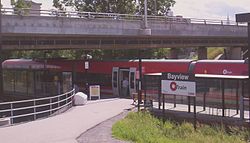 Bayview’s platform is at the northern terminus of the current line.
Bayview’s platform is at the northern terminus of the current line.
Long-term plans had included lines on Carling Avenue from the existing Carling station westward to Bayshore and Bells Corners, and from the Rideau Centre south-east to the area of Innes Road and Blair Road via Rideau Street, Montreal Road, and Blair Road. The City of Ottawa has conducted a $4 million Environmental Assessment Study for these two corridors. There were also possibilities of a rail link to Hurdman Station.
Service to Gatineau would also be possible (and desirable, considering the potential base of commuters), as there is a railway bridge over the Ottawa River nearby, but the government of Gatineau is opposed to extending the O-Train into their territory; Ottawa's city staff have taken steps to isolate the current north-south line from the bridge,[23] so it would need to be re-built north of Bayview station. A line running into Gatineau is not included in the current plans for expansion up to 2021, but the city is keeping this option open through its track acquisitions.
Mayor's Committee on Transportation
In January 2007, Mayor Larry O'Brien formed a special committee to review the city's transportation needs and provide a report to City Council by the beginning of June 2007. On 2007-06-01, this report[24] was presented to the Mayor, and was subsequently released to the media and the public on 2007-06-06. This report was criticized by some for planning service to Smiths Falls and Arnprior while neglecting to plan service to Rockland and Embrun, which are rapidly growing communities east of Ottawa (as of 2006[update]).
The committee, headed by former Member of Parliament and Cabinet Minister David Collenette, recommended that Ottawa's needs will be best served by light rail through the future. This plan calls for expansion of the system using current rail rights-of-way and stations (Via Rail, CP Rail, and Ottawa Central Railway), constructing new stations and a tunnel through the downtown core, going through the former Union Station (now currently the Government of Canada Conference Centre). The plan initially calls for using bi-mode diesel-electric trains or multiple units, allowing rapid expansion on current track powered by diesel engines, while switching to electric power through the tunnel downtown to remove the concerns about underground exhaust. Through the next thirty years, the plan calls for expansion of up to six lines, including links to surrounding municipalities, the City of Gatineau, and MacDonald-Cartier International Airport, with the lines gradually being electrified and expanded as required.
Only the initial portion of the project was budgeted, and using only rough numbers, but the committee feels that this can be completed for between $600 million to $900 million, including the downtown tunnel portion, within the next 5–10 years.
New transit plan
On November 28, 2007, City Council announced the expansion of rail service to Riverside South, as well as a downtown tunnel, with an environmental assessment study to determine whether it should be used by bus or rail service. Options were also open for additional extensions to Cumberland South to the east and south of Lincoln Fields Station at the Queensway via the current transitway.[25]
On March 3, 2008, the city of Ottawa revealed four different options for its transit expansion plan, and presented at Open House consultation meetings during the same week. All plans included the construction of a downtown tunnel or subway to accommodate transit service and possible addition of businesses underground, as well as the expansion of rapid transit to the suburbs. One of the plans includes light rail from Baseline Station to Blair Station and an expansion to the Ottawa Airport. All plans would have a completion date of about 2031, and costs are estimated at least $3 billion in total including $1 billion for the downtown tunnel.[26]
The majority of the public were in support of a downtown tunnel as well as the fourth transit option during public consultations meetings in Centretown, Barrhaven, Kanata and Orleans during the month. There were some suggesting that the light-rail service be extended to the suburbs rather than ending at the proposed stations. Concerns were particularly voiced by south-end residents where the initial rail plan was to be built.[27] On April 16, 2008, the Transit Committee tabled a document which recommended the fourth option.[28]
The plan passed City Council by a vote of 19-4, and included motions for possible rail extensions to the suburbs depending on population density and available funding.[29] However, Kitchissippi Ward councillor Christine Leadman expressed concerns of the environment integrity impacts of light-rail along the Ottawa River Parkway which is situated on NCC land. At least three councillors including Leadman, Capital Ward councillor Clive Doucet and Kanata North Ward councillor Marianne Wilkinson expressed preferences of light-rail service along Carling Avenue instead of the Parkway although rail would run through many traffic lights and stops. The NCC has also suggested the city to consider other options then the Ottawa River Parkway [30] while all three Ottawa Centre candidates for the 2008 federal elections, including incumbent New Democratic Party MP Paul Dewar, Liberal candidate Penny Collenette and Conservative candidate Brian McGarry have also expressed opposition to rail on the Parkway.[31]
Another potential route identified between Lincoln Fields and the Transitway near Westboro was a small strip of land located on the southern side of Richmond Road near the location of the defunct Byron Avenue streetcar line although costs would be much higher than the Parkway route.[32][33]
In early-September 2008, City staff suggested that first phase of the transit plan to be built would be similar to Option 3 with rail service from Riverside South to Blair Station via a downtown tunnel as well as the construction of a by-pass transit corridor via the General Hospital as well as a streetcar circuit along Carling Avenue although Alex Cullen mentioned that Council already rejected the option of streetcars running on that road. The first phase is planned to be completed by 2018.[34]
Current expansion plan
East-west line
Current plans call for a second east-west LRT line starting at Tunney's Pasture to Blair in the east end, with a tunnel running under Downtown.[35] The line is expected to open sometime between 2017 and 2019.[36]
Stations
There will be 13 stations along the LRT line.[37]
- Tunney's Pasture[38]
- Bayview, A major transfer point between the future east-west line and the current north-south line.[39]
- LeBreton Flats, Improving transit connections with Gatineau and create a new transit node along Booth Street.[40]
- Downtown West, Located under Queen Street, replacing the current Bay and Kent stations and with possible integration with Place de Ville.[41]
- Downtown East, Located under Queen Street, replacing the current Bank and Metcalfe stations.[42]
- Rideau, Located near the current Rideau Transit Mall, underneath the Government Conference Centre (the former Union Station). Replaces the existing Mackenzie King station.[43]
- Campus, Replacing the current Campus and Laurier stations serving the University of Ottawa.[44]
- Lees[45]
- Hurdman, A major transfer point between LRT and the Southeast Transitway.[46]
- Train, A transfer point to the Via Rail station.[47]
- St. Laurent, integrated with the St. Laurent Shopping Centre.[48]
- Cyrville[49]
- Blair, a major transfer point between the future LRT and Route 95 to Orleans.[50]
Expansion of existing line
On 18 May 2011, the Ottawa Transit Commission approved C$200,000 to study extending the existing O-Train line southwards to Leitrim and Riverside South.[4] The proposed extension was part of a C$59 million expansion that would include the purchase of six new trainsets and track improvements that would increase headways to eight minutes from fifteen.[4]
Fleet
The O-Train fleet has three trains of three cars each. The front and rear cars are powered and the centre towed. There is no fleet numbering: cars are identified by the letter C and a number (C1, C2, C3).
Class Image Type Top speed Number Routes operated Built mph km/h Talent BR643 
Diesel multiple unit 62 100 3 Bayview–Greenboro 2001 In September 2011, Alstom announced that they are to supply six new Coradia Lint trains, to be delivered in 2013.[51]
Facilities
Train sets are stored at the Walkley Yard located northeast of the Greenboro station. Maintenance is provided by Bombardier Transportation. Trains are towed to the site by Ottawa Central Railway locomotives, thus there are no work vehicles for the O-Train fleet.
The Walkley Yard was built in 1955 by the National Capital Commission for the Canadian National Railways and later sold to the Canadian Pacific Railway.
The yard has enclosed buildings for repairs and outdoor storage tracks.
- Year: 1955 (as O-Train facility 2001)
- Building: Yes
- Location: Albion Road North and Kitchener Avenue
- Status: Active
See also
References
- ^ "APTA transit ridership report, Fourth Quarter, 2010" (PDF). American Public Transportation Association. 2011-03-11. http://www.apta.com/resources/statistics/Documents/Ridership/2010_q4_ridership_APTA.pdf. Retrieved 2011-05-15.
- ^ "OC Transpo - Odometer passes 1 Millionth KM!". Octranspo1.com. http://www.octranspo1.com/routes/odometer_1_mil_km. Retrieved 2010-08-07.
- ^ Duncan, Paul. "Ottawa Railways" (GIF). NiagaraRails.com. http://www.niagararails.com/cgi-bin/img.cgi?/maps/otawatrm.gif. Retrieved 2009-01-12.
- ^ a b c "Ottawa O-Train extension proposed". Railway Gazette International. 24 May 2011. Archived from the original on 28 May 2011. http://www.webcitation.org/5z1jhrY0i. Retrieved 28 May 2011.
- ^ a b "O-Train Light Rail Project". http://www.tc.gc.ca/eng/programs/environment-utsp-otrainlightrailproject-973.htm. Retrieved 2011-04-05.
- ^ "Acec.ca". http://www.acec.ca/en/memberfirms/paidprofile.asp?track=dp&itemid=1254. Retrieved 2011-04-05.
- ^ "OC Transpo adds new low-floor articulated buses to its fleet". OC Transpo. 2001-04-05. Archived from the original on September 29, 2007. http://web.archive.org/web/20070929105859/http://www.octranspo.com/contacts/press_releases/2001/010405_LowFloorBuses.htm. Retrieved 2009-01-12.
- ^ "Report Apr 07 EN". City of Ottawa. http://ottawa.ca/residents/lrt/ns_line/council_reports/reportapr07_en.shtm.[dead link]
- ^ "Ottawa Light Rail Project Issues". Transport 2000. 2006-03-01. http://www.transport2000.ca/english/ottlrtmar06.htm.
- ^ "Transportation Committee Minutes 37". City of Ottawa. 2006-03-01. http://city.ottawa.on.ca/calendar/ottawa/citycouncil/trc/2006/03-01/minutes37.htm.
- ^ Jake Rupert (2006-10-25). "Chiarelli attacks Munter's light-rail alternative". Ottawa Citizen. http://www.canada.com/ottawacitizen/news/city/story.html?id=433b7aec-e5a7-438b-a79f-791b3bebf391.
- ^ Friends of the O-Train
- ^ Ottawa Transit group[dead link]
- ^ Derek Puddicombe (2006-12-05). "City fears $1B LRT lawsuit". Ottawa Sun. http://www.ottawasun.com/News/OttawaAndRegion/2006/12/05/2636827-sun.html.
- ^ Roman Zakaluzny (2006-12-05). "Council talks LRT one more time". Ottawa Business Journal. http://www.ottawabusinessjournal.com/287661522824313.php.
- ^ Nelly Elayoubi (2006-12-06). "Mayor's vote saves LRT project". Ottawa Sun. http://www.ottawasun.com/News/BreakingNews/2006/12/06/2654678.html.
- ^ "Absent councillor's vote could have stopped light rail approval". CBC News. 2006-12-08. http://www.cbc.ca/news/story/2006/12/08/bloess-rail.html.
- ^ "46930". CFRA. http://www.cfra.com/headlines/index.asp?cat=1&nid=46930.[dead link]
- ^ "Ottawa's light rail project veers off-track". CBC News. 2006-12-13. http://www.cbc.ca/canada/ottawa/story/2006/12/13/light-rail.html.
- ^ "Ottawa council kills light rail project". CBC News. 2006-12-14. http://www.cbc.ca/canada/ottawa/story/2006/12/14/lrt-vote.html.
- ^ "Ottawa's light rail gets another chance". CBC News. 2007-02-14. http://www.cbc.ca/canada/ottawa/story/2007/02/14/lrt.html.
- ^ "Ottawa's light rail deal dead for good". CBC News. 2007-02-23. http://www.cbc.ca/canada/ottawa/story/2007/02/23/lrt-poll.html.
- ^ "516". Ottawa Life. Archived from the original on September 27, 2007. http://web.archive.org/web/20070927035801/http%3A//www.ottawalife.com/article.asp%3Farticleid%3D516.
- ^ Moving Ottawa - En avant Ottawa
- ^ Rupert, Jake (November 29, 2007). "Council sets $2-billion transit priorities : Councillors admit finding cash, deciding what to build first 'difficult'". The Ottawa Citizen.
- ^ Dare, Patrick (March 4, 2008). "$1B tunnel worth the cost, mayor says". The Ottawa Citizen. http://www.canada.com/ottawacitizen/news/city/story.html?id=ff3c5618-07cc-46f8-b53d-434aada3a58f&k=32438.
- ^ CTV Ottawa (March 7, 2008). "South-enders angered by Ottawa's new transit plan". CTV. http://www.ctvottawa.ca/servlet/an/local/CTVNews/20080307/OTT_TRANSIT_UPSET_080703/20080307/?hub=OttawaHome.
- ^ Rupert, Jake (April 16, 2008). "Transit plan : City staff recommends a light-rail spine and downtown subway with bus transitways feeding it". The Ottawa Citizen. http://www.canada.com/ottawacitizen/news/story.html?id=dc84fffe-ae25-4d84-9563-3e0089fcf379&k=86100.
- ^ Rupert, Jake (May 28, 2008). "Passed: City council approved a new mass transit system based on electric light rail Wednesday". The Ottawa Citizen. http://www.canada.com/ottawacitizen/features/gettingthere/story.html?id=fdd3d15a-bdea-4d42-aebe-6a1f4ceede6c.
- ^ Adam, Mohammed (September 10, 2008). "NCC wants 'other options' to parkway rail". The Ottawa Citizen. http://canada.com/ottawacitizen/story.html?id=022c50bf-8fa7-45fe-8edb-32852cd9494e.
- ^ Doolittle, Nadine (September 15, 2008). "City’s voice lost in rail talk". Metro.ca. http://www.metronews.ca/ottawa/comment/article/112224.
- ^ Rupert, Jake (June 30, 2008). "The three-kilometre controversy". Ottawa Citizen. http://www.canada.com/ottawacitizen/news/story.html?id=e6929f65-b3c5-45ef-980a-17dc96a34e6c.
- ^ Puddicombe, Derek (July 17, 2008). "Route gathers steam". Ottawa Sun. http://www.ottawasun.com/News/OttawaAndRegion/2008/07/17/pf-6179546.html.
- ^ Puddicombe, Derek (September 12, 2008). "Trams and trains in transit tryouts". Ottawa Sun.
- ^ "City of Ottawa - Light Rail News December 11, 2009". City of Ottawa. http://ottawa.ca/residents/public_consult/transit_tunnel/lrt_newsletter_en.html. Retrieved 2010-01-08.
- ^ "Light-rail fast-track, Coventry Road footbridge plans sail through council". Ottawa Citizen. May 25, 2011. http://www.ottawacitizen.com/news/Light+rail+fast+track+Coventry+Road+footbridge+plans+sail+through/4837855/story.html.
- ^ Ottawa.ca Expansion stations and information
- ^ "City of Ottawa - Tunney's Pasture Station". Ottawa.ca. 2009-10-26. http://www.ottawa.ca/residents/public_consult/transit_tunnel/op_3/recommended_plan/tunneys_en.html. Retrieved 2010-08-07.
- ^ "City of Ottawa - Bayview Station". Ottawa.ca. 2009-10-26. http://www.ottawa.ca/residents/public_consult/transit_tunnel/op_3/recommended_plan/bayview_en.html. Retrieved 2010-08-07.
- ^ "City of Ottawa - LeBreton Station". Ottawa.ca. 2009-10-26. http://www.ottawa.ca/residents/public_consult/transit_tunnel/op_3/recommended_plan/lebreton_en.html. Retrieved 2010-08-07.
- ^ "City of Ottawa - Downtown West Station". Ottawa.ca. 2009-10-26. http://www.ottawa.ca/residents/public_consult/transit_tunnel/op_3/recommended_plan/downtown_west_en.html. Retrieved 2010-08-07.
- ^ "City of Ottawa - Downtown Station East". Ottawa.ca. 2009-10-26. http://www.ottawa.ca/residents/public_consult/transit_tunnel/op_3/recommended_plan/downtown_east_en.html. Retrieved 2010-08-07.
- ^ "City of Ottawa - Rideau Station". Ottawa.ca. 2009-10-26. http://www.ottawa.ca/residents/public_consult/transit_tunnel/op_3/recommended_plan/rideau_en.html. Retrieved 2010-08-07.
- ^ "City of Ottawa - Campus Station". Ottawa.ca. 2009-10-26. http://www.ottawa.ca/residents/public_consult/transit_tunnel/op_3/recommended_plan/campus_en.html. Retrieved 2010-08-07.
- ^ "City of Ottawa - Lees Station". Ottawa.ca. 2009-10-26. http://www.ottawa.ca/residents/public_consult/transit_tunnel/op_3/recommended_plan/lees_en.html. Retrieved 2010-08-07.
- ^ "City of Ottawa - Hurdman Station". Ottawa.ca. 2009-10-26. http://www.ottawa.ca/residents/public_consult/transit_tunnel/op_3/recommended_plan/hurdman_en.html. Retrieved 2010-08-07.
- ^ "City of Ottawa - Train Station". Ottawa.ca. 2009-10-26. http://www.ottawa.ca/residents/public_consult/transit_tunnel/op_3/recommended_plan/train_en.html. Retrieved 2010-08-07.
- ^ "City of Ottawa - St. Laurent Station". Ottawa.ca. 2009-10-26. http://www.ottawa.ca/residents/public_consult/transit_tunnel/op_3/recommended_plan/stlaurent_en.html. Retrieved 2010-08-07.
- ^ "City of Ottawa - Cyrville Station". Ottawa.ca. 2009-10-26. http://www.ottawa.ca/residents/public_consult/transit_tunnel/op_3/recommended_plan/cyrville_en.html. Retrieved 2010-08-07.
- ^ "City of Ottawa - Blair Station". Ottawa.ca. 2009-10-26. http://www.ottawa.ca/residents/public_consult/transit_tunnel/op_3/recommended_plan/blair_en.html. Retrieved 2010-08-07.
- ^ "OC Transpo chooses Alstom to supply six new commuter trains to Ottawa". Alstom. 2011-09-16. http://www.alstom.com/transport/news-and-events/press-releases/OC-Transpo-chooses-Alstom-to-supply-six-new-commuter-trains-to-Ottawa/.
External links
- O-Train official site (with information about current service)
- O-Train News
- Capital Railway certificate of fitness
- O-Train Evaluation Report
- O-Train Light Rail Project Summary (Transport Canada)
- O-Train construction pictures
- Salient Features of the Ottawa O Train Route
- Critical Analysis of Ottawa's Proposed North-South Light Rail Transit (LRT) Project
- Save Our Greenspace
- Friends of the O-Train and the new site: Friends of the O-Train
- Ottawa Light Rail official site (contains blog entries with updates regarding the project)
OC Transpo Rapid Transit Services OC Transpo Rapid Transit Routes Bus Rapid Transit Stations West: Stittsville · Terry Fox · Teron · Eagleson · Bayshore · Pinecrest
Southwest: Barrhaven Centre · Marketplace · Strandherd · Longfields · Fallowfield · Baseline · Iris · Queensway
Central: Lincoln Fields · Dominion · Westboro · Tunney's Pasture · Bayview · Lebreton · Bay · Kent · Bank · Metcalfe · Mackenzie King · Laurier · Campus · Lees · Hurdman
East: Train · St. Laurent · Cyrville · Blair · Jeanne d'Arc · Place d'Orleans · Trim · Millennium
Southeast: Lycée Claudel · Smyth · Riverside · Pleasant Park · Billings Bridge · Heron · Walkley · Greenboro · South Keys · Airport · Leitrim · Riverview
Future: TallwoodO-Train Stations Bayview · Carling · Carleton · Confederation · Greenboro · (Walkley Yard)
Passenger railways of Canada Intercity Sightseeing Commuter rail GO Transit (Greater Golden Horseshoe) • Agence métropolitaine de transport (Greater Montreal) • West Coast Express (Lower Mainland)Metro systems Light rail C-Train (Calgary) • Edmonton Light Rail • Hamilton Light Rail • Hurontario-Main Street LRT (Mississauga) • Kitchener-Waterloo Light Rail • O-Train (Ottawa) • Toronto Pearson Airport People MoverStreetcar Heritage tramways Downtown Historic Railway (Vancouver) • High Level Bridge Streetcar (Edmonton) • Nelson Electric Tramway • Whitehorse trolleySee also: Canadian railways • Light rail in Canada • Canada railwaysCategories:
Wikimedia Foundation. 2010.

